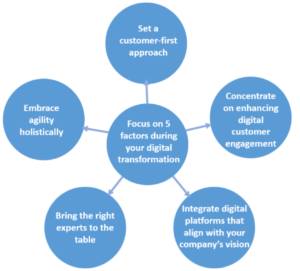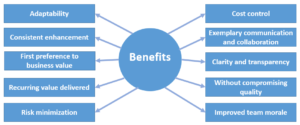A digital transformation is a process in which technology is used to completely change your business rather than focusing on a single IT project or a single area. Digital transformation means a series of projects that change every aspect of an organization and modernizes it with the latest technology.
To see substantial changes, your business’ technology leaders must lean away from the business of technology point of view and adopt a scalable, rapid, agile digital transformation approach.
Why Agile?
Digital transformation represents a fundamental change in organizational operation using the power of the latest technologies to create new forms of business and customer value. Agile development transforms how software is conceptualized, created, and delivered, and yields an exemplar framework for digital transformation by:
- Providing a framework to empower spontaneous iterations based on customer feedback
- Leading to a broader cultural shift in an organization
The agile approach is now a necessity for organizations to adjust promptly to evolving technologies and the rapidly changing market. The approach primarily focuses on daily scrums, sprints, iterative releases, and backlogs. Your business and other organizations must be willing, ready, and able to accept the continuous cycle of change of agile development, as this approach constantly embraces change through its iterative, incremental, and developmental phases.
Agile Best Practices
An agile framework changes how teams work together and leads to different company culture than how businesses typically operate, such as:
- Builds the right working environment – For example, making sure the burndown chart, which shows how much work a team has done on a project, is available to all team members.
- Recognizes and acknowledges success – Taking the time to recognize milestones and then sharing those accomplishments as a team is one piece of advice that sounds straightforward but has a big impact on our experience.
- Using frameworks to advance Agile initiatives – Many businesses would begin by implementing agile in a specific area of their operations. If your goal is to use agile to drive end-to-end change throughout your organization, then this will undoubtedly be difficult. Certain frameworks such as the Scaled Agile Framework (SAFe) exist to make scaling agile simpler.
- Provides employees a greater opportunity to gain assistance – Agile coaches, experienced scrum masters, and partners who deal with the technique daily will help you quickly catch up. By sharing knowledge and best practices, implementation will become remarkably simpler.
Develops New Customer Value
The digital transformation journey can often become difficult as you reinvent your business processes to be adaptable to new technologies. An agile approach makes the transformation easier. It assists in moving transformation from the IT department to the whole company and provides the framework for transformation, allowing a company to create the next wave of transformative digital experiences.
What Do You Need to Embrace for an Agile Digital Transformation?
Organizations are at a thrilling turning point to compete and sustain for the future, and this turning point is about maturing digitally to enhance customer experience and organizational agility. Your business should focus on these five factors during your digital transformation to create better customer value and encourage innovation:
- Set a customer-first approach – Prioritize high-value tasks by focusing on the value added to your employees or external stakeholders.
- Concentrate on enhancing digital customer engagement – Traditional digital or marketing projects are approached differently than digital customer experience projects. The customer experience is at the heart of digital technology. Customers appreciate receiving product/service updates, reviews, and demos across all platforms.
- Integrate digital platforms that align with your company’s vision – Management must develop a consistent digital transformation vision and communicate it to employees at all levels. Mobile applications, self-managed services, and virtual consultations were all made possible by the company’s digital platform.
- Bring the right experts to the table – The digital transformation team should include members from all company’s main divisions, including individuals with varying levels of experience.
- Embrace agility holistically – Traditional business models run project lifecycles with no time constraints. Customer demands may have changed by the time the project was completed. To keep up with new technology’s market demands, the company must make frequent changes. Each agile sprint will enable you to experiment and adapt on the fly.

The Pros and Cons of an Agile Digital Transformation
Digital transformation is about revolutionizing and sustaining your business operations in the long term by embracing the changing industry trends and new technologies. Some benefits of proceeding with an agile transformation include:
- Adaptability – The agile process is flexible and embraces transition. Selecting the right software for your company is important to ensure your business is flexible.
- Consistent enhancement – Throughout daily iterations, agile teams are constantly studying, collaborating, and adapting, evaluating what is going well and what can change.
- First preference to business value – The agile methodology ensures that the strategy is aligned and attentive to the needs of the company. Customer experience is enhanced by digital transformation.
- Recurring value delivered – As the project progresses, new features are added incrementally. Digital transformation is a never-ending operation.
- Risk minimization – When it comes to digital transformation projects, an agile strategy almost reduces the risk of failure. Due to daily updates, continuous communication, and regular testing at the end of each sprint, nothing is missed, and every problem is caught.
- Cost control – Maintaining the same sprint lengths during a project helps the team to know exactly how much work can be done and, as a result, how much each sprint will cost. It also permits daily budget adjustments.
- Exemplary communication and collaboration – Regular communication, constant collaboration, feedback sessions, and continuous stakeholder management are all important aspects of any transformation project.
- Clarity and transparency – Visibility across the business is achieved by frequent coordination, communication, and updates between multiple agile teams. Progress is tracked and expectations are managed with daily updates and progress charts.
- Without compromising quality – In an agile environment, work quality increases since testing and optimization begin at the beginning.
- Improved team morale – Self-management, daily information sharing, and continuous learning are all needed to build a highly motivated, high-performing team.

The Obstacles of This Transformation:
- Implementing an appropriate technology – Lack of expertise in certain technologies and tools can become a hurdle to their adoption.
- The existing organizational culture may affect transformation. Organizational culture changes take time, effort, and planning.
Agile is the Key to Transformation
Agile digital transformation allows businesses to be more responsive, do more with less, and better satisfy their customers’ needs. Effective digital transformation happens through continuous innovation, and while agile digital transformation has both benefits and disadvantages, it will save a lot of time and effort for companies that implement digital transformation. For more information on an agile approach, contact our experts today.


Excellent blog, Manjusha!!! It gives insight of important characteristics of an Agile Methodology and Practices. Agile is highly adopted in most of the organizations and it’s implementation is critical for business programs and projects. You have covered major aspects of agile methodology and framework here. Thanks a lot for sharing your knowledge and information. This will be definitely helpful for the start up projects and teams attempting for agile transformation!! – Tushar Mendhi
Thanks Tushar!
Very Nice